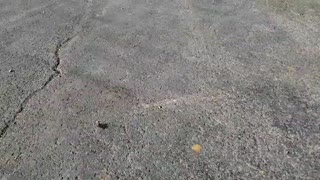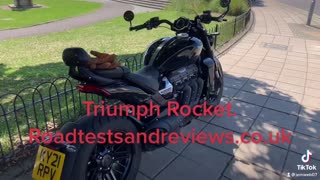Premium Only Content

1975 Triumph Spitfire
1975 Triumph spitfire, new top, color matched interior, inline 4 cylinder engine mated to a 4 speed manual gear box.
While the rest of the world saw 1500s with a compression ratio of 8.0:1, the American market model was fitted with a single Zenith-Stromberg carburettor and a compression ratio reduced to 7.5:1 to allow it to run on lower octane unleaded fuel.
Popular in street and rally racing, Spitfires won numerous SCCA National Sports Car Championships in F and G Production classes; won its class at the 1964 Tour de France rally, coming in second overall, and won the 1964 Geneva Rally. In 1965, a Spitfire won its class in the Alpine Rally.
There is a tendency among some Triumph enthusiasts to view the Spitfire as something less than a real Triumph. Yes, it was diminutive in terms of size and horsepower, but with more than 314,000 produced between 1962 and 1980 (on par with the entire TR line), it was the sports car heart of the company.
Triumph started as an auto manufacturer in 1923. It failed during the 1930s but was reborn after World War II under the umbrella of the Standard Car Co., best known for its saloons. Standard-Triumph premiered its first sports car, the TR2, in 1952. The TR2 was more successful than Standard saloons and was followed quickly by the TR3 and 3A. In 1958 Austin launched the tiny Donald Healey-designed Sprite to great success. A smaller roadster had also been discussed at Triumph and the Sprite's success encouraged the firm to produce it.
In late 1960 a prototype, codenamed “The Bomb,” was constructed in Turin by designer Giovanni Michelotti, using a Triumph Herald saloon chassis as its foundation. But the project was shelved when truck maker Leyland absorbed Standard-Triumph in 1960. A year later, a Leyland exec spotted The Bomb in a corner and the little sports car was given the go-ahead.
It debuted at the London motor show in October 1962 as the “Spitfire.” Synony-mous with the Battle of Britain fighter, the name resonated with the British public. Though more expensive, the Spitfire outsold the Sprite, offering more content than Austin's petite convertible. The Spitfire 4, as it was officially called, came with a 1147-cc derivative of the Herald engine, pushing it to 60 mph in 17 seconds and topping out at 92 mph. Sales took off in the United States as well, climbing steadily as successive iterations of the car, including the more powerful MkII and MkIII, appeared.
The Spitfire's racing potential was highlighted when Triumph decided to use it in place of the under-performing TR4 in 1964. Four fiberglass hardtop racers were built for Le Mans, one of which finished third in its class. The racer bodies foreshadowed the eventual GT6 Spitfire coupe but were campaigned with the same 1147-cc engines as their street counterparts. The cars raced successfully at Sebring that year and returned to Le Mans in 1965, taking first and second in class. Piloted by notables like David Hobbs, they also performed with distinction in various European rallies and in the SCCA where Bob Tullius took his Group 44 Spits to a number of wins in the late '60s.
Michelotti freshened the design in 1970 (MkIV), which featured rear suspension improvements and a stroked 1493-cc version of the four-banger good for 71 horsepower.
In 1973 British Leyland rebadged the model as the Spitfire 1500. Minor interior and exterior details changed but most significantly, emission and safety regulations were met with raised suspension, bumper and engine modifications. Lucas electrics and traditional reliability problems were still part of the package but more than 90,000 examples of the popular machine were sold. The 1500 continued in production until 1980 when stricter emission requirements convinced Leyland to retire its venerable sportster.
https://www.countryclassiccars.com/vehicles/359/1975-triumph-spitfire
-
 1:58
1:58
Country Classic Cars
1 year ago1954 Chevrolet Bel Air Sedan
149 -
 0:58
0:58
Country Classic Cars
2 years ago $0.01 earned1975 Triumph Spitfire
150 -
 1:00
1:00
Country Classic Cars
2 years ago $0.01 earned1975 Triumph TR6 Convertible
65 -
 26:32
26:32
Low Class Car Club Garage
3 years agoProject 69 Triumph Spitfire - Part 1
30 -
 1:01
1:01
jimbrophy22
2 years ago1973 Triumph TR6
29 -
 7:26
7:26
southerncrossCC
2 years agoTriumph Over Trauma
4 -
 0:19
0:19
Webb007
2 years agoTriumph Rocket 3 GT
18 -
 12:20
12:20
Low Class Car Club Garage
3 years agoProject 69 Triumph Spitfire - Things Go Bad - Part 2
11 -
 2:00
2:00
WTMJMilwaukee
2 years agoTragedy to Triumph
2 -
 2:45
2:45
Webb007
2 years agoTriumph Motorcycles Triple
2